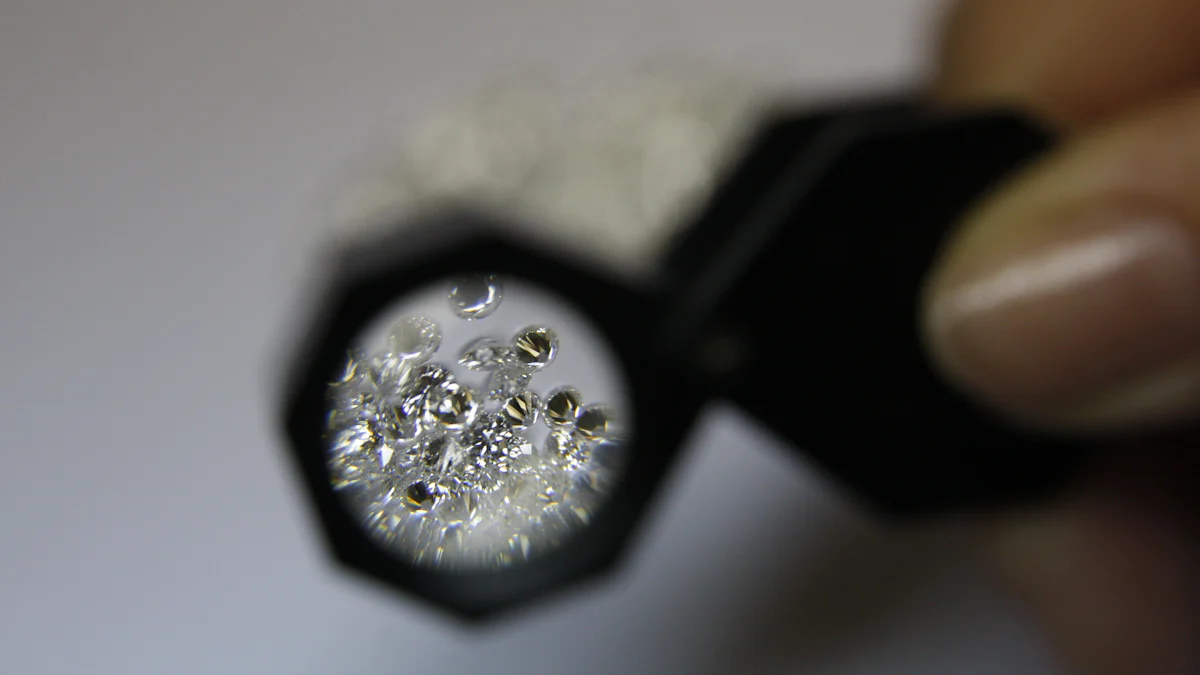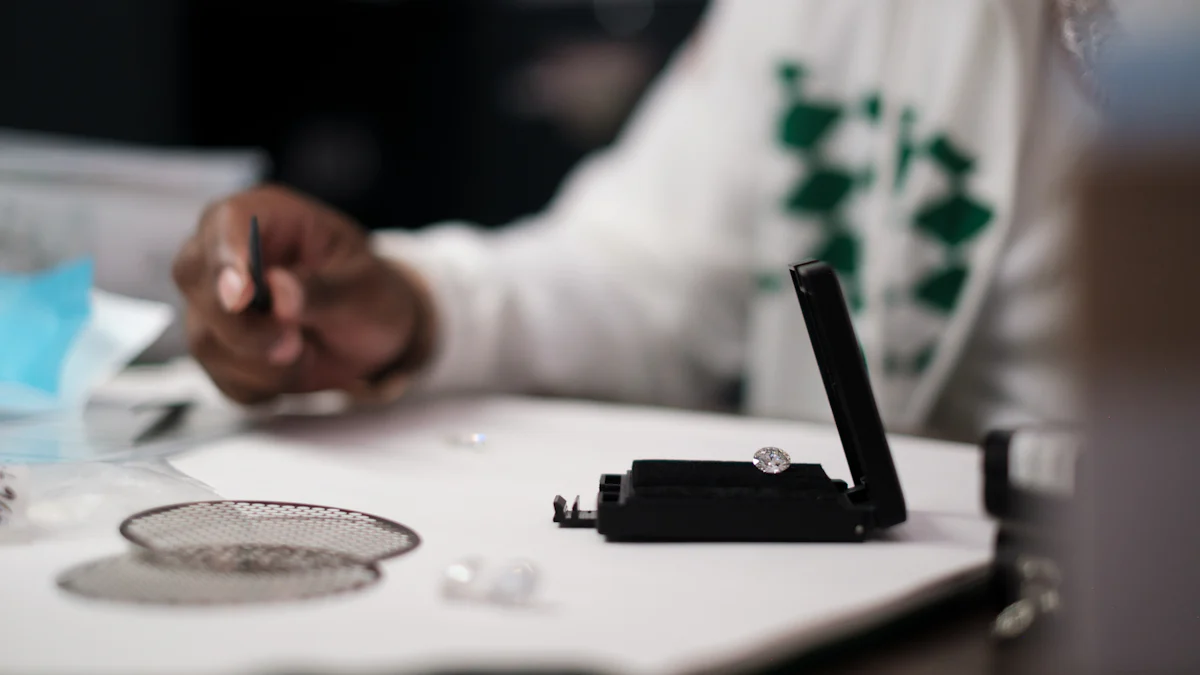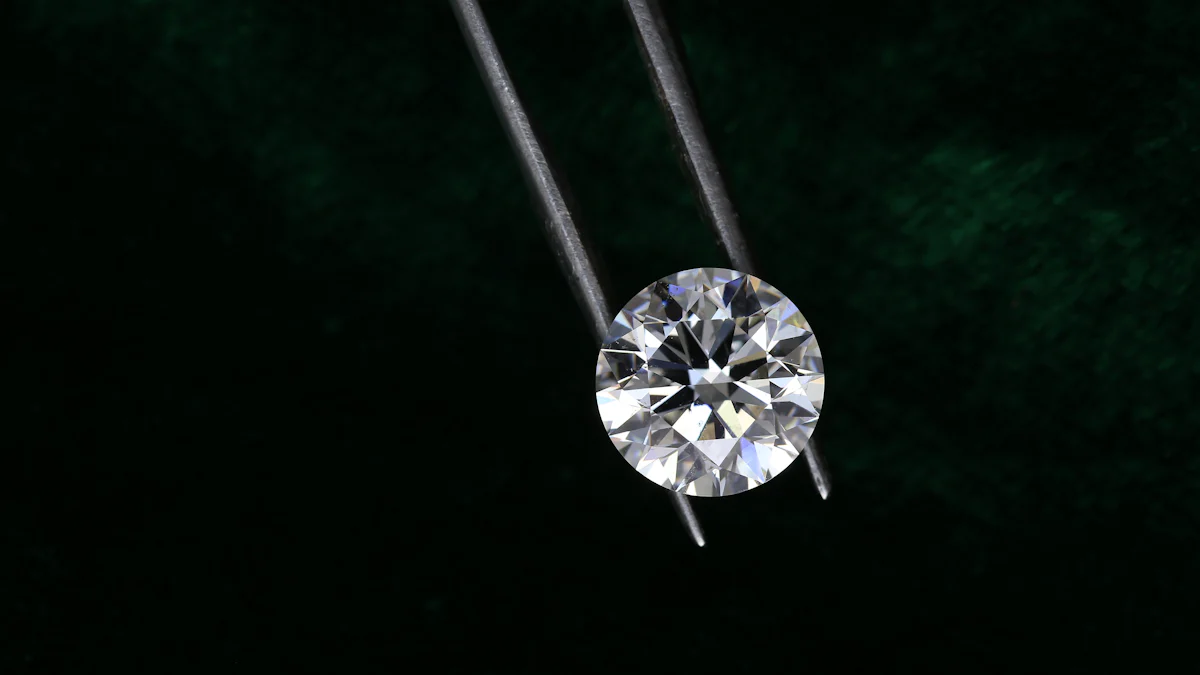5 Steps to Evaluate SI Diamonds Easily

SI diamonds offer a unique combination of affordability and quality, making them a popular choice for budget-conscious buyers. These diamonds often appear eye-clean, meaning their inclusions are not visible to the naked eye. Compared to higher clarity grades like VVS, SI diamonds provide excellent value without compromising on appearance. However, misconceptions exist, such as concerns about inclusions affecting durability or visibility in certain cuts. By understanding their characteristics, you can confidently select an SI diamond that balances beauty and cost effectively.
Understand SI Clarity
What SI Clarity Represents
SI clarity refers to diamonds with slight inclusions that are visible under 10x magnification. These inclusions can vary in size, number, and location. SI diamonds fall into two categories: SI1 and SI2. An SI1 diamond typically has fewer and smaller inclusions compared to an SI2. These inclusions may appear in different areas of the diamond, such as the center or near the girdle.
Gemologists evaluate SI clarity by identifying the grade-setting inclusion, which is the most prominent imperfection in the diamond. Most SI diamonds have one noticeable inclusion rather than multiple smaller ones. While inclusions in SI diamonds are more visible than in higher clarity grades, many SI diamonds still appear eye-clean, offering a balance between beauty and affordability.
Differences Between SI1 and SI2
The primary difference between SI1 and SI2 diamonds lies in the size and visibility of their inclusions. SI1 diamonds generally have fewer inclusions, which are smaller and less noticeable. In contrast, SI2 diamonds often feature larger or more prominent inclusions that may be visible to the naked eye.
| Clarity Grade | Inclusions | Visibility |
|---|---|---|
| SI1 | Fewer, smaller | Less noticeable |
| SI2 | More, larger | More noticeable |
Price differences between SI1 and SI2 diamonds can vary depending on the specific stone. On average, SI1 diamonds cost 5-15% more than SI2 diamonds. However, other factors like cut and carat weight also influence the final price.
Why SI Diamonds Are a Great Value
SI diamonds offer excellent value for buyers seeking a balance between quality and cost. Compared to higher clarity grades like VVS, SI diamonds are significantly more affordable. While VVS diamonds have near-flawless appearances, their inclusions are almost impossible to detect, even under magnification. SI diamonds, on the other hand, provide a visually appealing option at a fraction of the cost.
| Feature | SI Diamonds | VVS Diamonds |
|---|---|---|
| Inclusions | Noticeable under magnification and sometimes with the naked eye | Extremely difficult to detect under magnification |
| Overall Appearance | Lower visual appeal due to inclusions | Near-flawless appearance |
| Value | Significantly lower compared to VVS | Higher due to clarity |
If you prioritize an eye-clean diamond, SI1 diamonds are often the better choice. They combine affordability with a clean appearance, making them a popular option for engagement rings and other jewelry.
Inspect Inclusions in SI Diamonds

Tools to Examine Inclusions
To evaluate inclusions in SI diamonds, you need the right tools. A jeweler’s loupe with 10x magnification is essential for spotting imperfections. This tool helps you see the size, shape, and location of inclusions. Clarity plots, often included in diamond certifications, provide a detailed map of these imperfections. They show where inclusions are located and how they might affect the diamond’s appearance.
Consulting with a trusted jeweler is another effective way to assess inclusions. Jewelers have the expertise to explain whether specific inclusions impact the diamond’s brilliance or durability. Their insights can help you make an informed decision.
Identifying Eye-Clean SI Diamonds
An eye-clean diamond has no visible inclusions when viewed without magnification. While many SI1 diamonds meet this standard, only about 30% of SI2 diamonds are considered eye-clean. This means most SI2 diamonds have inclusions visible to the naked eye.
To identify an eye-clean diamond, examine it under natural lighting. Look for any imperfections that catch your attention. Focus on the table, or the top flat surface, as inclusions here are more noticeable. If you’re unsure, ask the jeweler to point out inclusions and explain their visibility.
Importance of Inclusion Location and Size
The size and location of inclusions significantly affect a diamond’s appearance. Larger inclusions are more noticeable and can reduce the diamond’s brilliance. Inclusions near the center of the table are especially visible and can impact the diamond’s clarity grade.
Here’s how inclusion size and location matter:
- Larger inclusions have a greater impact on clarity and brilliance.
- Inclusions near the center of the diamond are harder to hide and more distracting.
Inclusions near the edges, however, can often be concealed by the diamond’s setting. This makes them less noticeable and less likely to affect the diamond’s overall beauty.
When evaluating SI diamonds, prioritize those with smaller inclusions located near the edges. This ensures the diamond maintains its brilliance and visual appeal.
Focus on Cut Quality

How Cut Impacts Diamond Brilliance
The cut quality of a diamond plays a crucial role in its brilliance and sparkle. A well-cut diamond reflects light effectively, creating a dazzling display of brightness, fire, and scintillation. Brilliance refers to the white light reflected from the diamond, while fire is the colorful light that bounces off its facets. Scintillation describes the flashes of sparkle you see when the diamond moves under light.
When a diamond is cut with precision, it reflects almost all incoming light through its table, enhancing its brilliance. Poorly cut diamonds, on the other hand, fail to reflect light properly. They often appear dull or lifeless. Factors like symmetry, proportions, and facet placement determine how well a diamond refracts and reflects light. To ensure maximum brilliance, always prioritize cut quality when evaluating si diamonds.
Choosing Excellent or Very Good Cuts
Selecting a diamond with an Excellent or Very Good cut grade ensures superior brilliance and fire. These grades represent the highest levels of craftsmanship in diamond cutting. The table below highlights the characteristics of these cut qualities:
| Cut Quality | Characteristics |
|---|---|
| Excellent | Reflects nearly all incoming light, offering unmatched brilliance and fire. |
| Very Good | Reflects most light, providing exceptional sparkle visible to the naked eye. |
Both options deliver stunning visual appeal. However, Excellent cuts offer the highest level of light performance. If your budget allows, prioritize this grade for maximum sparkle.
Why Cut Matters More Than Clarity
Cut quality has a greater impact on a diamond’s beauty than clarity. A well-cut diamond reflects and refracts light more effectively, enhancing its overall appearance. Even if a diamond has minor inclusions, a superior cut can mask these imperfections by maximizing brilliance.
Here’s why cut quality should take precedence:
- It significantly influences a diamond's brilliance and sparkle.
- Poor cuts result in dull, lifeless diamonds, regardless of clarity grade.
- Proportions, symmetry, and polish in a well-cut diamond enhance its visual appeal.
While clarity is important, it doesn’t affect a diamond’s beauty as profoundly as cut quality does. Always prioritize cut when choosing a diamond to ensure it looks vibrant and radiant.
Evaluate Color and Carat
Understanding Diamond Color Grades
Diamond color grades measure how colorless a diamond appears. The Gemological Institute of America (GIA) developed a grading scale ranging from D (completely colorless) to Z (light yellow or brown). Diamonds graded D to F are considered colorless and are the most valuable. These diamonds have no visible tint, even under magnification.
Near-colorless diamonds, graded G to J, offer excellent value. They may show a faint yellowish tint but often appear white or clear to the naked eye, especially when viewed alone. Most buyers prefer diamonds in this range for their balance of beauty and affordability. The difference between color grades is subtle and usually requires professional evaluation.
When choosing SI diamonds, near-colorless grades (G to J) are popular. They provide a visually appealing option without the premium price of colorless diamonds.
Selecting the Right Carat Weight
Carat weight refers to a diamond’s size, but bigger doesn’t always mean better. Larger diamonds are rarer, which causes their price to increase exponentially. For example, a two-carat diamond costs significantly more than two one-carat diamonds of the same quality.
While a larger carat weight may sound appealing, it doesn’t guarantee better brilliance or sparkle. A well-cut diamond with a smaller carat weight often looks more stunning than a poorly cut, larger diamond. If you’re on a budget but want a specific carat size, consider compromising on color or clarity. This approach allows you to save money without sacrificing the diamond’s overall appearance.
Balancing Clarity, Color, and Carat
Balancing these three factors is key to selecting the perfect diamond. For SI diamonds, prioritize a higher color grade over clarity, as inclusions are often invisible to the naked eye. This strategy ensures the diamond looks vibrant while staying within budget.
Choosing SI diamonds also gives you flexibility. You can allocate more of your budget to carat weight or cut quality, ensuring the diamond meets your preferences. By focusing on what matters most to you, you can find a diamond that offers exceptional value and beauty.
Compare Certifications and Prices
Importance of GIA and AGS Certifications
When buying SI diamonds, certifications from reputable grading laboratories like GIA (Gemological Institute of America) and AGS (American Gem Society) play a crucial role. These certifications verify the diamond’s quality, ensuring you get what you pay for. Diamonds graded by GIA and AGS are widely trusted because of their rigorous evaluation processes.
The table below highlights the differences between GIA and AGS certifications:
| Feature | GIA | AGS |
|---|---|---|
| Cut Grading | Overall cut assessment for round diamonds | Comprehensive cut grading for multiple shapes |
| Color and Clarity | Rigorous grading standards | Similar methodology to GIA |
| Reputation | Established for color and clarity | Known for cut quality analysis |
Certifications from these labs enhance consumer confidence. For example, GIA and AGS diamonds often command higher prices due to their verified quality. On the other hand, labs with mixed reputations, like EGL, may reduce trust and affect resale value. Always prioritize diamonds with GIA or AGS certifications to ensure quality and transparency.
Comparing Prices Across Vendors
Prices for SI diamonds can vary significantly between vendors. Comparing prices helps you find the best deal without compromising quality. The table below shows average price ranges for SI diamonds based on carat weight:
| Carat Weight | Price Range |
|---|---|
| 0.50 | $900 - $2,000 |
| 1.00 | $4,000 - $5,500 |
| 2.00 | $12,000 - $25,000 |
When comparing prices, consider factors like quality, size, and certification. Larger diamonds cost more, but cut quality and clarity also influence the price. Demand can also affect pricing. For instance, trends or economic conditions may cause prices to fluctuate. Be cautious of vendors claiming to sell at wholesale prices, as these offers can sometimes be misleading.
Avoiding Overpayment for SI Diamonds
To avoid overpaying, focus on the clarity grade and its impact on price. SI1 diamonds typically cost about 10% more than SI2 diamonds. The table below illustrates this difference:
| Clarity Grade | Average Cost Difference |
|---|---|
| SI1 | 10% more than SI2 |
| SI2 | Baseline for comparison |
You should also evaluate the diamond’s overall quality. A certified SI diamond with excellent cut and near-colorless grade offers better value than a poorly cut diamond with higher clarity. By balancing clarity, cut, and carat weight, you can find a diamond that fits your budget without sacrificing beauty.
Evaluating SI diamonds becomes simple when you focus on clarity, cut, color, and carat. Start by understanding clarity features and avoiding inclusions near the surface or center table. Eye-clean diamonds offer exceptional value, appearing flawless to the naked eye while saving you money. Prioritize cut quality above all else, as it enhances brilliance and conceals minor inclusions. Balance the 4 C’s thoughtfully, ensuring no single factor compromises the diamond’s overall beauty. By following these steps, you can confidently select a stunning SI diamond that fits your budget and preferences.
FAQ
What does "eye-clean" mean for SI diamonds?
An eye-clean diamond has no visible inclusions when viewed without magnification. Many SI1 diamonds meet this standard, while fewer SI2 diamonds do. Always inspect the diamond under natural light to confirm its appearance.
Should I prioritize cut or clarity when buying an SI diamond?
Cut quality matters more than clarity. A well-cut diamond enhances brilliance and sparkle, even if it has minor inclusions. Focus on Excellent or Very Good cuts to maximize the diamond’s beauty.
Are SI diamonds durable despite their inclusions?
Yes, SI diamonds are durable for everyday wear. Most inclusions in SI diamonds are small and do not affect the diamond’s structural integrity. However, avoid diamonds with large inclusions near the edges.
Can I find affordable SI diamonds with good color grades?
Yes, near-colorless grades (G to J) offer excellent value. These diamonds appear white to the naked eye and cost less than colorless grades. Pairing a near-colorless diamond with an SI clarity grade maximizes affordability.
How do I ensure I’m buying a certified SI diamond?
Look for diamonds graded by GIA or AGS. These certifications guarantee accurate assessments of clarity, cut, color, and carat. Avoid uncertified diamonds or those graded by less reputable labs to ensure quality.
See Also
Tips for Spotting Authentic Diamond Rings at Home
A Guide to Different Diamond Cuts for Engagement Rings
Comprehensive Steps for Selecting a White Diamond Ring

